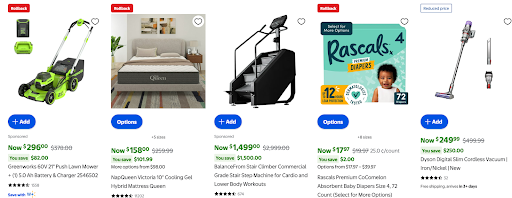
Walmart’s online presence is growing fast. In December 2024 alone, the retailer’s website pulled in over 551 million monthly visitors, with users spending an average of 12 minutes per session—a 25% increase from the previous year.
Their total revenue for fiscal year 2024 soared to $648 billion, a sharp jump from $420 billion in 2023. E-commerce sales crossed $100 billion and are showing strong momentum, making up 15.4% of total revenue—growing much faster than Walmart’s overall business.
With numbers like these, it’s no surprise that Walmart is becoming a serious competitor in online retail, making Amazon sellers take notice.
If you’re already selling on Amazon, you’ve likely thought about expanding to Walmart Marketplace. The good news? You’ve already done most of the groundwork. The challenge? Walmart operates differently, and success isn’t just a copy-paste job from Amazon.
Before making the leap, here are some things you need to know to set yourself up for success on Walmart.
1) Ask yourself if Walmart is the right marketplace for your products
Not every Amazon best-seller is a perfect fit for Walmart. Unlike Amazon’s diverse audience, Walmart’s marketplace caters more to budget-conscious shoppers looking for everyday essentials rather than premium or luxury items.

What works well on Walmart?
- Affordable, high-demand products – Think home essentials, groceries, and everyday use items.
- Competitive pricing – Walmart prioritizes low-cost options, so if your margins rely on premium pricing, reconsider.
- One-size-fits-all or simple variations – Unlike Amazon, Walmart customers aren’t huge on hyper-customization.
What might not work?
- Luxury, niche, or premium-priced products – Walmart shoppers expect deals.
- Highly specialized or brand-loyalty-driven items – If your product depends on strong brand equity, success might be slower.
- Fragile or complex fulfillment needs – Walmart’s strict shipping standards can make handling delicate items tricky.
Before jumping in, check with your Amazon seller consulting agency if Walmart’s audience aligns with your product strategy. If your product sells well in big-box retail stores or discount chains, Walmart could be a game-changer. But if you thrive on high-margin, brand-driven sales, you may need to rethink your approach.
2) Understand Walmart’s strict seller approval requirements
Getting approved to sell on Walmart isn’t as easy as signing up for Amazon. They don’t accept just anyone—you need to prove you’re a reliable, experienced seller who can compete on price, fulfillment, and quality.
What Walmart wants:
- Established e-commerce experience – Prior success on Amazon, Shopify, or another marketplace.
- Competitive pricing – Your products can’t be priced higher than on other platforms.
- Fast and reliable fulfillment – Walmart expects efficient shipping and low order cancellation rates.
What can get you rejected?
- New or small-scale sellers – If you don’t have a strong sales history, approval is tough.
- Inconsistent fulfillment – High late shipments or frequent stockouts are red flags.
- Brand-new private label products – Walmart favors well-known brands or products with proven demand.
Before applying, make sure your business meets Walmart’s strict criteria. If you’re already killing it on Amazon with competitive pricing and fast shipping, you’ve got a strong shot. Otherwise, work on building your credibility first! Contact Walmart selling consultants to know more.
3) Confirm that your brand is strong enough to stand out in Walmart’s marketplace
Selling on Walmart isn’t just about listing your products—it’s about standing out in a crowded marketplace. Unlike Amazon, Walmart shoppers are less brand-loyal and more deal-driven, so your brand needs to work harder to grab attention.

What makes a brand Walmart-ready?
- Strong sales history – If your products sell well on Amazon, there’s a good chance they’ll perform on Walmart too.
- Clear, compelling branding – Professional product images, engaging descriptions, and customer trust signals matter.
- Competitive pricing – Shoppers on Walmart look for value, not premium branding alone.
What might hold you back?
- Niche, luxury, or unknown brands – Walmart isn’t the best place to build a high-end brand from scratch.
- Weak product positioning – If your product doesn’t stand out visually or in pricing, it’ll get lost.
- Poor review history – Low ratings on Amazon? Walmart’s AI might deprioritize your listings.
Before jumping in, assess if your brand has enough recognition and appeal to compete. If you’re not a household name, focus on creating eye-catching listings, competitive pricing, and strong product differentiation.
4) Check if your pricing strategy aligns with Walmart’s competitive rules
Walmart is obsessed with low prices, and if your pricing isn’t competitive, you could lose sales—or worse, get delisted. Unlike Amazon, Walmart enforces a price parity rule, meaning your product can’t be cheaper elsewhere (including Amazon).

What you need to know:
- Price match policy – Walmart automatically adjusts prices to stay competitive.
- Everyday Low Price (EDLP) – Discounts and aggressive pricing help boost rankings.
- Lower ad costs – Since Walmart has fewer sellers, you might spend less on ads to stay visible.
What can hurt your sales?
- Higher prices than Amazon – Walmart can suppress your listing if it finds a lower price elsewhere.
- Frequent price changes – Walmart prefers stable pricing, unlike Amazon’s dynamic pricing model.
- Low margins – If your costs are already tight, Walmart’s pricing expectations may squeeze your profits.
Before listing, analyze your costs and competitor pricing. If you can’t stay competitive without killing your margins, Walmart might not be the right fit for your product.
5) Evaluate if Walmart’s fee structure makes sense for your margins
Walmart’s fee structure is different from Amazon’s, and not every product will be profitable. There’s no monthly subscription fee like Amazon’s, but the referral fees, fulfillment costs, and price-matching rules can impact your margins.

What to consider:
- Referral fees – Usually 8–15% per sale, depending on the category.
- No monthly seller fee – Unlike Amazon’s $39.99/month for pro sellers, Walmart only charges per sale.
- Walmart Fulfillment Services (WFS) – Competitive with FBA, but pricing varies by product size and weight.
What can eat into your profits?
- Price parity rule – If your product is cheaper elsewhere (including Amazon), Walmart can lower your price automatically.
- Strict return policies – You cover return shipping, which can add unexpected costs.
- Advertising costs – Walmart Connect ads are essential for visibility but can eat into margins.
Before listing, run the numbers. Compare Walmart’s referral fees, fulfillment costs, and price competition to your margins on Amazon. If your profits are already razor-thin, Walmart might not be the right move.
6) Learn how Walmart’s advertising and promotions work
Advertising on Walmart is not the same as Amazon PPC—it’s newer, less competitive, but also less advanced. If you want visibility, you’ll need to understand Walmart Connect and how promotions work.
Key advertising options:
- Sponsored Products – Boosts product visibility in search results (like Amazon PPC).
- Sponsored Brands – Increases brand awareness with banner ads.
- Display Ads – Appears across Walmart.com, including product pages and checkout.
What makes Walmart ads different?
- Lower competition, but also lower traffic – Less bidding wars, but fewer shoppers compared to Amazon.
- No exact match keywords – Walmart’s system auto-optimizes placements rather than giving full manual control.
- Strict ad eligibility – Not all products qualify for advertising, so check before launching campaigns.
On top of ads, Walmart offers discount promotions like Rollbacks and Clearance to help boost sales. Mastering these tools early will give you a competitive edge as Walmart’s ad platform continues to grow.
7) Choose the right team or Walmart agency to handle Walmart selling
Managing Walmart isn’t just a copy-paste job from Amazon. It requires a dedicated team or expert who understands Walmart’s platform, pricing rules, and fulfillment expectations. The wrong approach can tank your success before you even start.
Who can handle your Walmart operations?
- In-house team – Train your current e-commerce staff if they have the bandwidth and expertise.
- Walmart agency or consultant – Experienced professionals who specialize in Walmart Marketplace can fast-track success.
- Walmart Virtual assistants – Useful for listing management, order processing, and basic customer support.
What can go wrong?
- Assuming Amazon strategies will work – Walmart has different SEO, ad, and fulfillment rules.
- Underestimating customer service demands – Walmart has strict response time expectations.
- Lack of expertise in Walmart advertising – Running ads on Walmart Connect requires a different strategy than Amazon PPC.
Before expanding, decide who will manage your Walmart store. If you’re serious about making it work, invest in the right team or partner to avoid costly mistakes.






